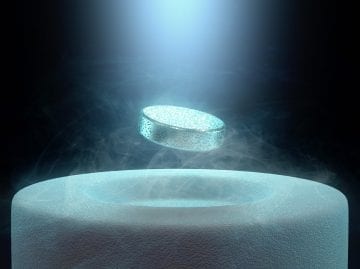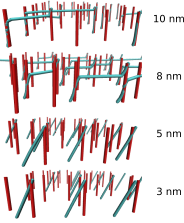Superconductors
T he most widely known property of superconductors is electrical conductivity without any resistance below a certain critical temperature. In addition, they also do not allow magnetic field inside, which leads to to the often seen demonstration of a magnet levitating on top of the superconductor. Both properties make superconductors very attractive for applications, whereas the required low temperature is often an obstacle. Despite that, superconductors are widely used, e.g. in magnetic resonance imaging (MRI) machines and in practically all other places where large magnetic fields are required. These magnets usually use low temperature superconductors which require cooling with expensive liquid helium. But since 1986, also liquid nitrogen cooled high temperature superconductors have been known, and these are even more attractive.
he most widely known property of superconductors is electrical conductivity without any resistance below a certain critical temperature. In addition, they also do not allow magnetic field inside, which leads to to the often seen demonstration of a magnet levitating on top of the superconductor. Both properties make superconductors very attractive for applications, whereas the required low temperature is often an obstacle. Despite that, superconductors are widely used, e.g. in magnetic resonance imaging (MRI) machines and in practically all other places where large magnetic fields are required. These magnets usually use low temperature superconductors which require cooling with expensive liquid helium. But since 1986, also liquid nitrogen cooled high temperature superconductors have been known, and these are even more attractive.
 In the Wihuri Physical Laboratory we have concentrated on improving the critical current density of YBa2Cu3O6+x (YBCO) superconductor, which has a critical temperature of 92 K. In high magnetic fields, the field can penetrate the superconductor in form of magnetic vortices. If these vortices start to move, a voltage is observed and the superconducting state is lost. Therefore, we have developed several ways of growing self-assembled nanorods of different non-superconducting materials within the YBCO thin film to pin the vortices to place. The physics of these vortices has been studied extensively experimentally and with molecular dynamics simulations. We also design and fabricate microwave resonators to be used as the readout elements of the qubits in spin quantum computers.
In the Wihuri Physical Laboratory we have concentrated on improving the critical current density of YBa2Cu3O6+x (YBCO) superconductor, which has a critical temperature of 92 K. In high magnetic fields, the field can penetrate the superconductor in form of magnetic vortices. If these vortices start to move, a voltage is observed and the superconducting state is lost. Therefore, we have developed several ways of growing self-assembled nanorods of different non-superconducting materials within the YBCO thin film to pin the vortices to place. The physics of these vortices has been studied extensively experimentally and with molecular dynamics simulations. We also design and fabricate microwave resonators to be used as the readout elements of the qubits in spin quantum computers.